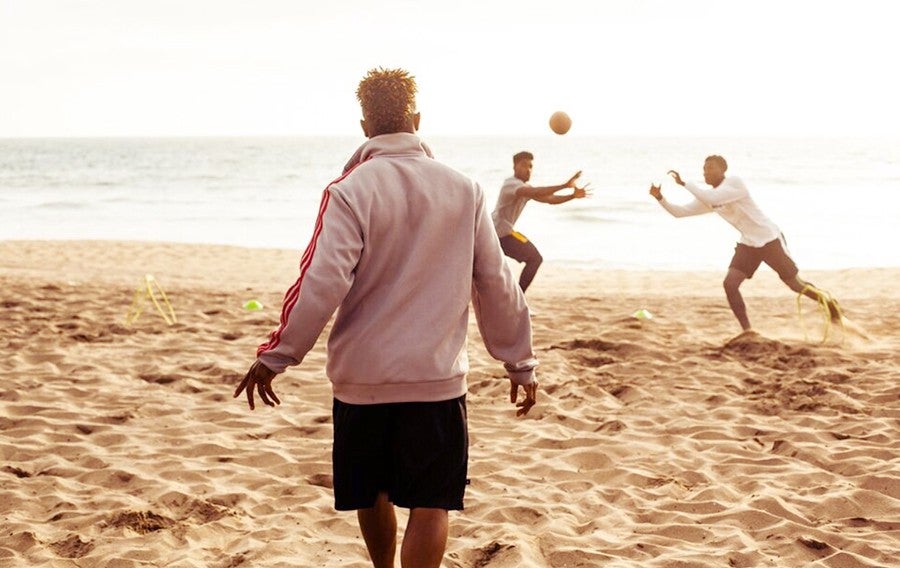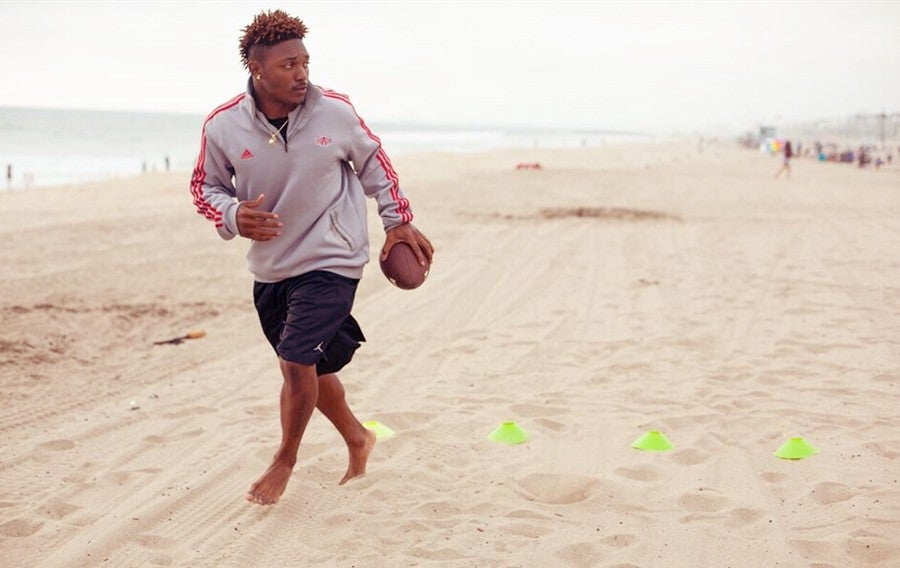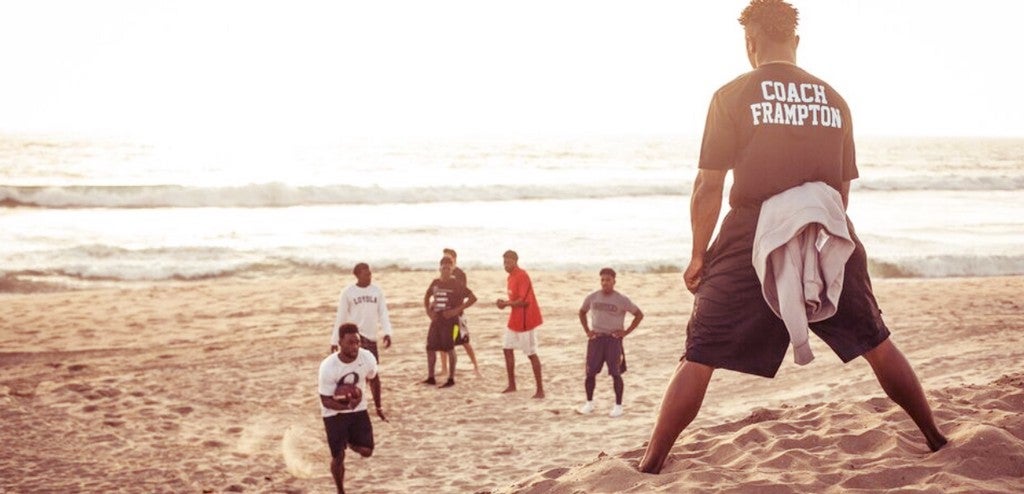Wielding an iPhone as his baton, Dwayne Frampton Jr. works the field of Long Beach Poly High School like an orchestra conductor one afternoon last month. But for this former foot soldier in the Rolling 40s Neighborhood Crips, there are no strings or horns sections to speak of — just an 18-year-old named Jack Jones and his cleats chewing up the grass as his feet struggle to keep up with Frampton’s orders.
“Give me a little less chatter,” Frampton barks.
“That was a little too on the mark.”
Halfway between the Billie Jean King Tennis Courts and Tony Gwynn Field, a crowd of a dozen onlookers has formed to watch the impromptu spectacle of Jones — one of the nation’s top high school football players (who committed to the University of Southern California in February via a video made by and co-starring hometown hero Snoop Dogg) — sprinting and backstepping at the behest of Frampton, who has suddenly emerged as one of football’s most sought-after trainers.

It’s a small audience compared to some of Frampton’s training sessions, which can draw up to a hundred people — and tens of thousands more viewers online — when one of his A-List clients, like the Washington Redskins’ DeSean Jackson, comes through to train.
“Don’t dime stop. Get around the hoop and give me a release.”
“Cool, cool. Okay, let’s take it from the top.”
Sweaty and panting, Jones reaches for Frampton’s iPhone to approve the clip he’s posting to Instagram, Frampton’s primary means of marketing his fledgling business.
So far, it seems to be working: In just 18 months, Frampton has added Jackson, Kevin Durant, Robert Griffin III and Odell Beckham Jr. to his roster. But his target demographic is high school athletes, whose parents are willing to pay for just about anything to give their kids an edge in getting recruited to top football programs.
“He put an evolutionary twist on [training],” says three-time Pro Bowl selection Jackson, who was one of Frampton’s first high-profile clients. “He uses the cones in crazy ways and it’s like they are stand-ins for the defenders. It gives you that sense of being attacked by defenders.” Footwork is choreographed down to the inch, lending the workouts a balletic feel. Trainees are forced to multitask, twisting, getting bumped, sprinting and catching in a single drill.
“Hips and feet is what I have mastered,” says Frampton, who is 5 feet 8 inches tall and built like an anvil. But he also has mastered social branding and promotion. High school students are drawn not just to his unconventional training techniques but to his ability to get them noticed via his Instagram account, where his 74,000 followers include NCAA football coaches and scouts.
Frampton started out as a one-man Instagram account and quickly morphed into a burgeoning brand, with short clips of clients often working out on the sands of Dockweiler Beach, near LAX airport. As celebrity clients helped draw more eyeballs to his posts (and a sponsorship deal with Adidas), his three-day FrampCamp training sessions soon drew in hundreds of clients each time. The workouts and camps may be the core of his business, but it’s the viral nature of his Instagram videos that has proved training sessions can be an attraction unto themselves: An Instagram post last week showing Beckham Jr. and DeSean Jackson working out at UCLA drew more than 160,000 views on FrampCamp’s Instagram page and was picked up by several New York media outlets.

Things clearly could’ve gone much differently for Frampton, whose father was convicted of attempted murder when he was 9 and is currently serving a 50-year sentence. Raised by his mother and uncles in Crenshaw, Frampton saw a football scholarship as a ticket out of the violence, drug-dealing and gangbanging that scooped up so many of his peers. After his own brushes with law enforcement cost him multiple scholarship offers at top NCAA programs, he settled on a local junior college and soon transferred out to Arkansas State, where he laid the foundation for what would become his training program.
“I just started throwing cones together and repetitiously mastering the movements. [At Arkansas State] after our first game against the University of Louisville, it worked — so I just kept throwing cones and ladders into different game-like situations and went from there,” he says.
After a promising junior season at Arkansas State, his stock among NFL scouts was on the rise. He was expected to be at least a sixth-round draft pick — that is, until the second quarter of a January 8th college bowl game, when he ran an out route and had his knee snapped by a defender, tearing his MCL and ending his NFL dreams.
“My goal since I was a child was to go to the NFL. I had everything riding on that game — a combine invitation, my Senior Bowl invite,” he says. He never fully recovered, and a failed comeback forced him back to L.A., where he leaned on his boxing skills to make ends meet, competing in local underground boxing circuits. Then his best friend was killed, just the latest in a string of old friends to die by gun violence.
“I went into a state of depression. I attempted suicide several times. I questioned my faith. I questioned my religion. I was at rock bottom,” he says.
He found salvation in the elder of his two sons, Hakeem. “He gave me some look, like, ‘Dad, I need you.’ And I started training my son — and that’s why I am talking to you now.”
After he posted a few of those training sessions of 8-year-old Hakeem running routes and doing sprints on Instagram, he caught the attention of Jackson, who contacted him to ask for a session.

“And then everybody started coming. That’s it. It wasn’t no rocket science.”
What will be tricky, however, is how to take the brand he so deftly created and scale it up into a sustainable business. His strategy is twofold: To create a subscription based online platform for athletes training across a range of sports, and to sell a documentary-style reality show about his life and work that will capitalize on the growing audience for this new form of entertainment.
Today long-form, behind-the-scenes athletic programming like the NFL Combine on ESPN and HBO’s Hard Knocks is being challenged by bite-sized chunks of media on social media. A number of companies are pushing into this space, including L.A. startup Sportle which recently livestreamed four of Manny Pacquiao’s workouts. After Houston Texan defensive end J.J. Watt documented a massive box jump as part of his recovery from groin surgery on Twitter, USA Today reposted it on their sports blog.
Frampton knows his content has the potential to reach a much larger audience — and potentially form the basis of some kind of new media company — and is securing seed investment. But in the meantime, Frampton’s focused on students like Jones, who will go on to live the NFL dream Frampton was denied.
“I’m a locksmith. I can get something out every kid that their parents can’t,” says Frampton, now seated on the outside patio of TGI Friday’s in Ladera Heights during happy hour. It’s the same parking lot where another one of his friends was killed by a rival gang years earlier.
“Everything changes,” he says. “It’s my turn. I just got to maximize my time.”
Peter Kiefer is a L.A.-based writer.
More football on MEL:
- In the NFL, It’s a Negative to Care About Anything Other Than Football
- The Largest Football Player on Earth
- The NFL’s Forgotten Retirees
